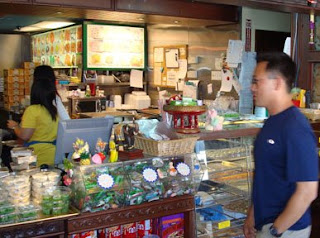 posted by jonathan liljeblad
posted by jonathan liljebladName: Bhan Kanom Thai
Location: 5271 Hollywood Blvd., Los Angeles, CA. 90027
Food: Thai, but just dessert
Service: Pleasant
Ambience: Just take out, with seating sacrificed for delicacies
Price: Cheap ($3-6 per dessert pack)
Most Westerners are oblivious to Thai desserts. Tell them about Thai food, and the first image in their head is usually of pad thai or pad kee ew or chicken satay or papaya salad. The idea of Thai dessert is a completely alien concept.
Which is actually a bit odd, considering that Thailand has a rich array of sweets in their culture, and accord it a dedicated place in their national cuisine. In some tourism circles, it's even promoted as one of the primary experiences for tourists--you can get a basic orientation at sites like Bangkok.com, Thaiways Magazine, Phuket Magazine, and Enjoy Thai Food. Thai desserts, called khanom in the Thai language, can be traced in the historical record to at least the Sukhothai period (1238-1350), and are known to have become popular during the Ayutthaya period (1350-1767). The creative explosion in Thai desserts are popularly attributed to a woman named Marie Guimar Phaulkon, who was a mixed-race (Portuguese, Japanese, and Bengali) wife of First Minister Constantine Phaulkon during the late 17th and early 18th centuries, and introduced the ingredients of her heritage (particularly eggs and sugar) to expand the creativity available in formulating Thai dessert recipes.
To be fair, there are major reasons why authentic desserts are frequently left off the menu or ignored by most Thai restaurants: it's highly perishable, and it can be difficult to make. Much of the desserts require fresh ingredients, which when combined quickly lose their unique textures and flavors whether left on the counter or placed in the fridge. Personally I've noticed that they tend to lose their original qualities within a day, maybe less if it's warm or humid. This brief window of culinary enjoyability makes it difficult to justify the hours of preparation time, which frequently involve multiple ingredients layered in complex sequences with careful details in delicate chemistry.
Which is unfortunate, because Thai desserts, if fresh, and done well, are heaven.
They can be sweet, but not overly so. They can be filling, but not overly so. They can be heavy, but can also be light. They can be rich, but also simple. They can be overwhelming, but also subtle. There are desserts that are like bread, or cookies, or cakes, or pies. There are creams, gelatins, custards, tortes, dumplings, steamed, baked, or fried. There is fruity, there is sugary, there is syrupy, there is crunchy, there is chewy, there is smooth, there is melt-in-your-mouth and linger like the daydream of a tropical beach on a lazy warm day.
 One of the better places in Los Angeles to view the diversity of Thai desserts is Bhan Kanom Thai. Located in Thai Town near the Thai Plaza, it's dedicated solely to Thai desserts. So much so, in fact, that you'll find yourself hard-pressed to make your way into the store and through the aisles to even see the selection--and when you do, chances are you'll have to make your way through the logjam of locals who know what they want and are trying to make a quick stop and the visitors who have no clue and are trying to figure out what they're looking at, let alone how to buy.
One of the better places in Los Angeles to view the diversity of Thai desserts is Bhan Kanom Thai. Located in Thai Town near the Thai Plaza, it's dedicated solely to Thai desserts. So much so, in fact, that you'll find yourself hard-pressed to make your way into the store and through the aisles to even see the selection--and when you do, chances are you'll have to make your way through the logjam of locals who know what they want and are trying to make a quick stop and the visitors who have no clue and are trying to figure out what they're looking at, let alone how to buy.Most of the items in Bhan Kanom Thai are sold in lots, with an order being a packet of 4-6 individual bite-sized items. Most Westerners won't be able to tell what's in them--there's no way to identify the ingredients from the appearance or from the labels; you'll have to make do asking the staff behind the counter (assuming things are not too busy).
Not to fear. Pretty much everything is good. And as long as you remember it's dessert, and are happy that dessert is supposed to be some type and texture and flavor of sweet, you won't go wrong.









